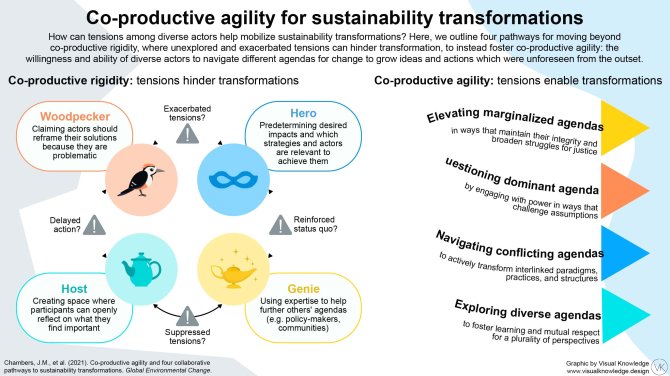
News
How to turn tension into transformation
One could imagine when researchers and people outside academia work together in a “co-production” process, things do not always run smoothly. With competing interests, agendas and ways of seeing the world, tensions can certainly arise. Think about high-level climate meetings like COP26. But with the right approach, tension can be used to create broad ownership and action for transformative change, according to new research published in Global Environmental Change.
Agility is vital
The study, which was led by Josephine Chambers from the Forest and Nature Conservation Policy (FNP) group at Wageningen University, with fellow Wageningen researcher Jeanne Nel and a team of 40 international scientists, analysed 32 initiatives worldwide to develop practical guidance for navigating tensions and power dynamics among co-production participants.
The study is a follow-up from a previous paper in Nature Sustainability where they explore when and how particular co-production approaches may be effective or constructive.
Chambers and her colleagues suggest that “co-productive agility” is vital for turning tensions into transformations. Co-productive agility is the willingness and ability of diverse actors to engage in reflexive dialogues to develop shared ideas and actions that would not have been possible from the outset.
Exacerbating or suppressing tensions can ultimately hinder transformation. An emphasis on ‘agility’ can support actors to engage with seemingly contradictory agendas
Four ways to facilitate
The authors argue that too much time is spent debating which agenda for change is best, instead of finding ways to facilitate better interactions among different interests.
They describe four archetypal roles, highlighting how their approaches may suppress or exacerbate tensions to ultimately hinder transformation:
- The hero keeps substantial control over processes to pursue their own desired outcomes based on their perception of the problem
- The woodpecker seeks to critique and reframe solutions claiming they are problematic
- The genie explicitly chooses to release control, thereby allowing specific actors to set the agenda and further existing motivations and goals
- The host opens up spaces for reflection and learning, often among relatively like-minded actors. The released control can make it difficult to identify tensions in the room.
The paper outlines key design choices that can help foster agility among these roles by balancing decision-making power and reflection with action. They identify four complementary pathways where co-productive agility can turn tensions into transformations. These pathways help elevate marginalized agendas, question dominant agendas, navigate conflicting agendas, and explore diverse agendas – all facilitating broader processes of transformation. For example, by collaboratively engaging powerful actors in processes that question dominant assumptions, it becomes possible to develop much more radical solutions to broad social and environmental problems.
Overall, the authors conclude: “We hope that by sharing our collective experiences in navigating the tensions and politics of transformation, we can enable more agile and powerful pathways to just and sustainable futures”.
- Interested to use this paper as a tool in collaborative processes or teaching? Download a brief practical guide on how role plays can be used to explore how to design for agility among the four archetypes.
- What does it sound like to turn tensions into transformations? Watch the musical abstract where each archetype is translated into a different musical instrument, and explore how they seek to foster agility.
